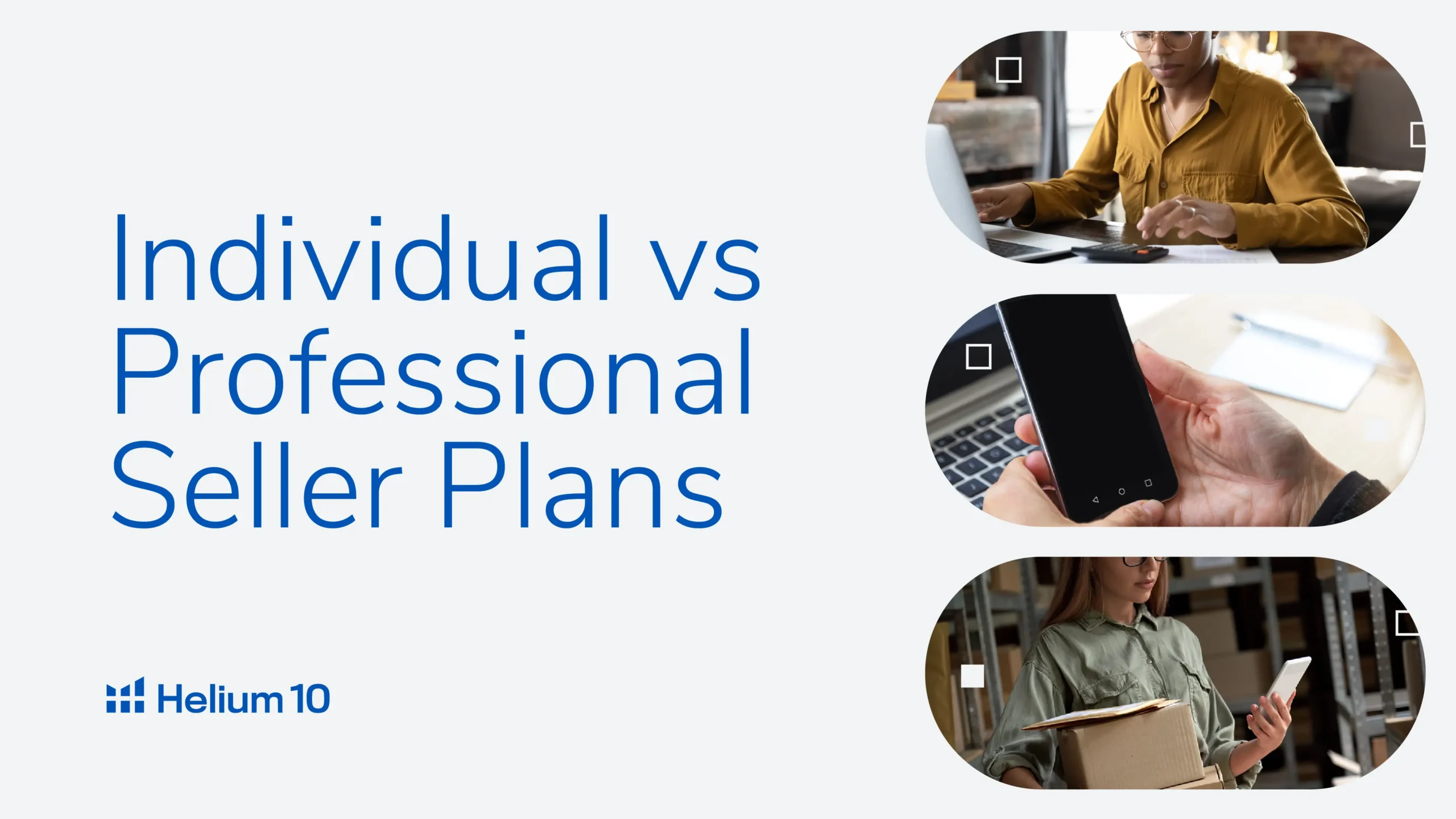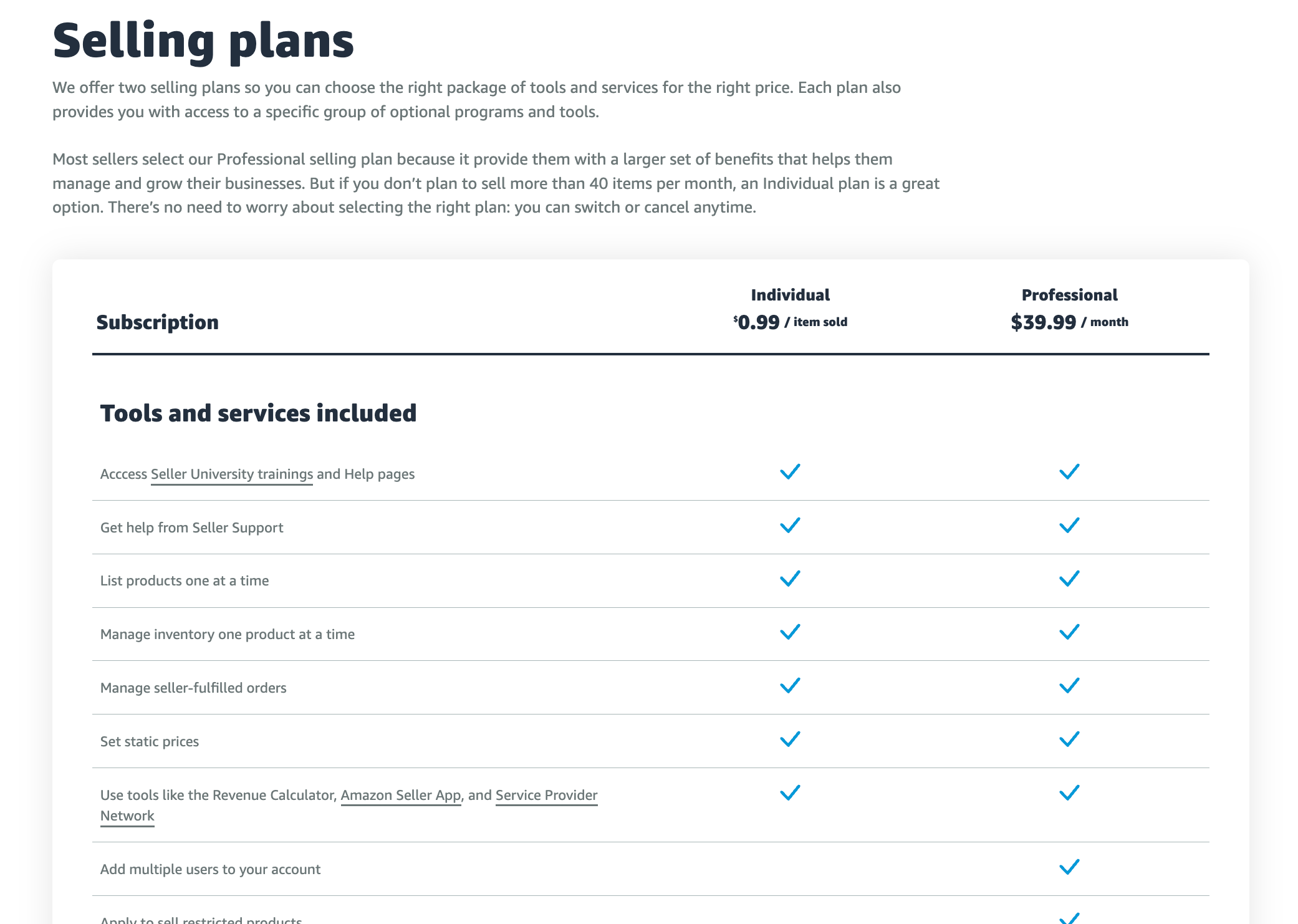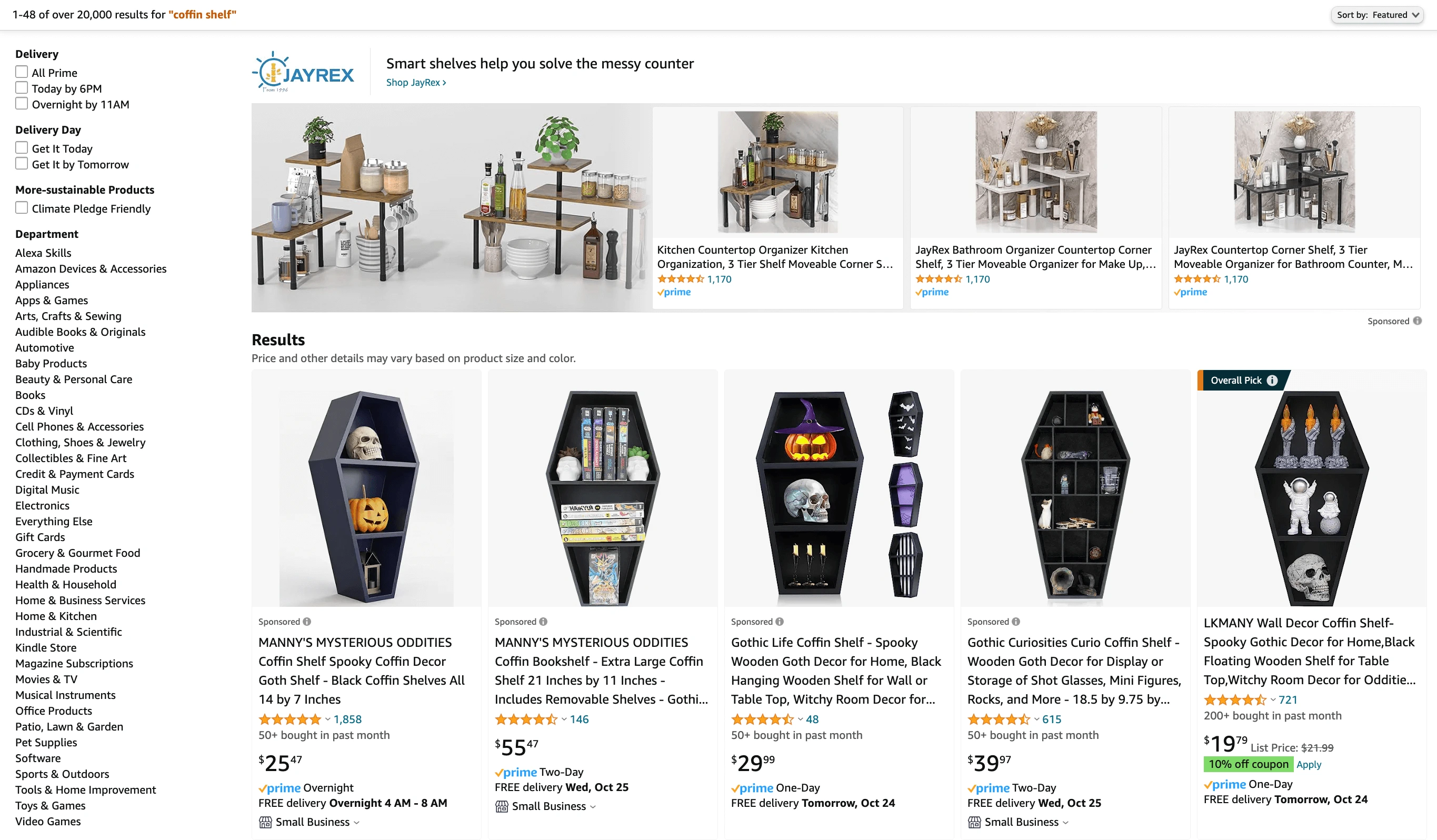
Amazon Individual vs Professional Seller Plans: How to Choose


Table of Contents
- First, Who Are the Amazon Seller Accounts For?
- What Are the Primary Features of an Individual Seller Plan on Amazon?
- What Are the Primary Features of a Professional Seller Plan on Amazon?
- Individual vs. Professional Seller Plan Fee Structure
- Considerations When Choosing a Plan
- Which Fulfillment Option Do You Want?
- How Many Products Can You Sell Each Month?
- Do You Want to Buy Box Access?
- Do You Want Restricted Category Access?
- Do You Want Featured Listing Placements?
- Do You Intend to Run Amazon PPC Campaigns?
- How Do You Want to Handle Taxes?
- Do You Intend to Run Discounts/Promotions?
- Which Reports Do You Want Access To?
- Do You Want the Ability to Complete Bulk Actions?
- Are You Using 3rd Party Apps and Tools?
- Choose What Works for You
Researching how to sell on Amazon?
Maybe you have been trying to figure out whether you should be opting for an Amazon individual account or a professional seller account when just getting started.
In this article, we’ll cover both of the primary seller plans: Individual and Professional to help you figure out which one is best suited to your business. Bear in mind, that each plan caters to different seller needs, making it that much more important to understand features, fee structures, and associated considerations before making an informed decision.

First, Who Are the Amazon Seller Accounts For?
The Amazon Individual Seller account is appropriate for those who want to sell on Amazon infrequently and on a small scale. With this type of account, you don’t pay a monthly fee but instead pay per-item selling fees. Though relatively easy to set up, it does have its limitations. Individual sellers can create listings, but they may not have access to advanced selling features or tools.
On the other hand, the Amazon Professional Seller account is designed for more serious sellers looking to sell on Amazon as a professional venture. This will add $39.99 as an expense fee to the bottom line of your business every month; however, it comes with access to a broader range of features and capabilities. With a Professional Seller account, you can create listings in bulk, use Amazon’s advertising tools, employ a more advanced fulfillment strategy, and allow multiple users to manage the account. Meaning if you own a business with multiple team members involved in selling on Amazon, then Professional Seller accounts may be more suitable for you.
You can adjust later as needed based on your selling goals and volume by starting with the Amazon individual seller account with its pay-as-you-go approach before transitioning to an Amazon professional seller account. The registration process for both account types is relatively straightforward. Just provide the necessary account info and agree to Amazon’s seller terms and policies.
What Are the Primary Features of an Individual Seller Plan on Amazon?

Being particularly great if you’re looking to sell just a few items or to test the waters before committing to a larger operation, the Amazon Individual Seller account can help you keep costs down in the beginning by being charged $0.99 per item sold.
You can think of the item fees as referral fees as they are what help Amazon’s platform cover costs while generating income. It is calculated as a percentage of the product’s sale price.
Also, when you start selling on Amazon with an Amazon Individual Seller account, you will still get access to Seller University training, help from Seller support whenever you need it, the ability to list products and manage inventory one at a time, manage seller-fulfilled orders, set static prices, and use Amazon’s tools such as their revenue calculator, Amazon Seller App, Service Provider Network.
Yet, one key aspect to note with an individual seller account is that you won’t have access to Amazon’s FBA (Fulfillment by Amazon) service, which can streamline the fulfillment process leading you to be responsible for your shipping fees, both for shipping your products to customers and for returns, if applicable.
Don’t know what Amazon FBA is? Read up all about it here.
You also will not have access to certain advanced features such as brand registry and the ability to create enhanced brand content for their product listings. This can limit your ability to build a distinct brand identity on Amazon’s platform.
What Are the Primary Features of a Professional Seller Plan on Amazon?
The above compares to an Amazon Professional Seller Plan which is tailored for more serious sellers who have a vision for substantial growth and efficiency in mind.
Suppose a professional selling plan is the route you decide to go, with the monthly subscription fee tagged to your Amazon seller account. In that case, you get access to a wide array of advanced tools and features essential for managing a high volume of sales and inventory effectively as I mentioned above.
The host of benefits include bulk listing and uploading capabilities, customizable shipping rates, promotional tools, the opportunity to compete to be the Featured Offer on Amazon, integration with selling apps with SP-API, access to reports and analytics to optimize sales strategies, and more. Not to mention, Professional Sellers are eligible to participate in Amazon’s exclusive programs like Amazon Vine and the ability to sell in restricted categories, opening up new opportunities for business expansion and increased visibility.
Particularly, the ability to list and manage inventory in bulk is helpful if perhaps, you have had an established business for several years and have a large set of inventory you plan to list and sell. Professional sellers can also leverage Amazon’s FBA (Fulfillment by Amazon) service, which allows for streamlined order fulfillment and access to Amazon’s extensive fulfillment network, providing fast and reliable shipping for customers.
As for referral fees for professional seller accounts, they can vary by category, potentially reducing the cost per sale. With the opportunity to qualify for A+ listings, a strong brand presence on Amazon is also a strong plus. At any time, you have a desire to tap into their arsenal of tools for managing inventory efficiently, tracking sales performance, and optimizing advertising campaigns can help refine your processes.
Individual vs. Professional Seller Plan Fee Structure
To reiterate, the Individual Seller Plan involves no monthly subscription fee; sellers pay a per-item selling fee for each product sold. On the other hand, the Professional Seller Plan requires a monthly subscription fee of $39.99, providing a more cost-effective approach for high-volume sellers, as they can list an unlimited number of products without incurring additional per-item fees. This fee structure difference often directs sellers toward the plan that best suits their sales volume and business goals.
Considerations When Choosing a Plan
Okay, so we’ve briefly summed up the plans.
And now maybe your mind is wandering into logistics.
You’re thinking about the considerations since you understand the fundamental differences.
So let’s jump into some of those questions you may have on your mind.
Which Fulfillment Option Do You Want?
Like… Shivali, what if I’m just starting, but I want to use Amazon’s fulfillment method for fulfilling my orders?
Well, it’s exactly what you think, my friend. If you want the fulfillment route, you’ll have to opt for a professional Amazon seller account even if you are a smaller-scale seller.
The Individual Seller Plan entails fulfilling orders yourself, giving you control over the shipping process, but the Professional Seller Plan offers Fulfillment by Amazon (FBA) service with which you can be more hands-on letting Amazon handle your picking, packing, shipping, and customer service, allowing you to focus more on scaling your business and enhancing customer experience.
This choice significantly impacts how you manage your operations and the level of control and convenience you seek in fulfilling orders on the Amazon platform.
How Many Products Can You Sell Each Month?
If you are okay with the do-it-yourself fulfillment stipulation and you have only a few products that you think you can manage through focused attention on each listing, then by all means, go for the individual seller accounts option. If you have many SKUs you feel may be more difficult to manage, then a professional Amazon seller account is suggested.
Do You Want to Buy Box Access?
First, what is the “Buy Box?” The Buy Box is a coveted spot on Amazon’s product page, directly affecting your visibility and sales. It is that rectangular section on a product detail page where customers can click to add an item to their cart and make a purchase. When multiple sellers offer the same product, Amazon uses a complex algorithm to determine which seller gets the Buy Box for that product at any given time. Winning the Buy Box is highly advantageous for sellers because it can lead to increased sales. Factors influencing Buy Box eligibility include price, shipping options, seller rating, fulfillment method (Fulfillment by Amazon or Fulfilled by Merchant), and customer service. It’s also Amazon’s way of highlighting its competitive offers though it is worth noting that not all products have a Buy Box, and for some, it may rotate among eligible sellers. Your choice of plan should align with your strategy for winning the Buy Box and maximizing your sales potential on the platform.
The Individual Seller Plan doesn’t grant access to the Buy Box, limiting your exposure and potentially impacting your sales performance.
As a private label seller, you should have the Buy Box but if you are dabbling in other avenues such as wholesale/arbitrage, might help you to pay the monthly just to have the opportunity to compete for this prime position, potentially boosting your sales and expanding your customer base.
Do You Want Restricted Category Access?
“Restricted Category Access” on Amazon denotes the constraints imposed on certain product categories, necessitating sellers to fulfill specific prerequisites or obtain approval from Amazon before they can list and sell items within these categories. These restrictions are implemented to uphold regulatory compliance, safeguard consumers, and maintain product quality on the platform.
Sellers aspiring to offer products in a restricted category are typically required to undergo a comprehensive review or application process. The criteria for how you gain access to these categories vary, encompassing factors like business verification, quality and safety standards, experience and performance metrics, and adherence to specific Amazon policies and guidelines.
For instance, sellers may need to provide documentation to verify their status as legitimate businesses and to ensure compliance with any legal or regulatory prerequisites associated with the category. You may also need to demonstrate that your products meet rigorous quality and safety standards to guarantee your prospective buyer’s well-being.
Moreover, Amazon may mandate a particular level of seller experience or the maintenance of high-performance metrics as prerequisites for accessing these restricted categories. Sellers must also strictly comply with Amazon’s specific policies and guidelines about the restricted category in question. These policies can span issues such as authenticity, intellectual property rights, and product condition.
Common examples of restricted categories on Amazon encompass health and personal care, beauty, grocery, jewelry, and automotive. Though criteria and approval processes are subject to change over time, making it that much more reason for you to routinely consult Amazon’s seller resources and guidelines to remain up-to-date with the latest information IF you are interested in those categories.
On the topic of contemplating Amazon’s Individual versus Professional Seller Plans specifically, the Professional Seller Plan offers eligibility to sell in various restricted categories, granting you the ability to diversify your product range and reach a broader customer base. Conversely, the Individual Seller Plan restricts your access to these categories, potentially limiting your product offerings and market reach. Your choice in this regard should align with your product niche and business growth strategy, ensuring you can sell the products you intend to and target a wider market if needed.
Do You Want Featured Listing Placements?

Comparatively, you can think of Featured Listing Placements on Amazon as the prized endcap displays in a bustling retail store—these are the coveted spots where your products get the spotlight. Just like the endcap displays grab the attention of shoppers, these placements put the front and center of your listing in the Amazon marketplace, hopefully captivating your audience as it is among the first things potential customers see.
But to secure these prime spots, Amazon offers advertising services such as Amazon Sponsored Products and Amazon Sponsored Brands, where you can bid and pay for these highly visible placements. These premium placements may not be included in your standard plan.
It is only with the Professional Seller Plan that you truly get the advantage of being eligible for featured listing placements, increasing your product’s visibility and chances of attracting potential customers.
Do You Intend to Run Amazon PPC Campaigns?
This brings me to the discussion of running Amazon PPC campaigns.
First of all, the days for which you could just list your product and start generating sales are gone.
Marketing efforts are a must and that means PPC. Yes, you could drive traffic from external sites and hope that is enough, but wouldn’t it be nicer to have an added protective layer with PPC?
If you can make it work, the professional seller account is a good idea for hiking product visibility, driving traffic, and multiplying sales. With this plan, you have the tools and access needed to create and manage effective PPC campaigns. Conversely, the Individual Seller Plan may not be as conducive to leveraging PPC effectively due to limitations in campaign management tools and options. Your choice should align with your advertising strategy and the level of control and effectiveness you seek in PPC campaigns to maximize your product’s reach and sales potential when deliberating between Amazon’s Individual and Professional Seller Plans.
How Do You Want to Handle Taxes?
Then, we have taxes.
A super fun topic!
You should take some time to try and understand the tax implications of your sales on Amazon. If you are running your Amazon business as a sole proprietor or as a part of your finances, you’ll typically report your earnings on your personal income tax return. With an Individual Seller account, you have a lower monthly fee, but you’re also responsible for calculating and remitting sales tax for transactions in states where you have a tax obligation, which can be a complex process due to varying state tax laws.
On the other hand, a Professional Seller account might be more suitable if you intend to operate your Amazon business as a legal entity, such as an LLC or corporation. This can provide some liability protection and may have different tax implications. Of course, when needed, consult with a tax professional to determine the most tax-efficient structure for your specific situation and to ensure you are complying with sales tax obligations, income tax reporting, and other tax-related requirements in the jurisdictions where you operate.
Amazon also has a service called Marketplace Tax Collection (MTC), which automatically calculates, collects, and remits sales tax on behalf of sellers for orders shipped to customers in states with marketplace facilitator laws. Depending on your sales volume and the states you operate in, this can simplify your tax compliance.
Do You Intend to Run Discounts/Promotions?
This is an important question to consider because the discounts and promotions offered by the two seller account types on Amazon, Individual, and Professional, differ significantly in terms of scope and availability.
With an Individual Seller account, you have limited access to creating discounts and promotions. You can utilize basic promotions like “Money Off” promotions, which allow you to offer discounts on your products, but you won’t have access to more advanced promotional tools. Individual sellers also can’t participate in Lightning Deals or use the “Early Reviewer Program” to solicit reviews for their products, which can help with visibility and sales.
In contrast, a Professional Seller account provides a larger range of promotional opportunities. Professional sellers can create more sophisticated promotions, including “Percentage Off” promotions, which allow percentage-based discounts, “Buy One, Get One” promotions, and volume-based discounts. They also have access to Lightning Deals, a time-limited, high-visibility promotion. Professional sellers can also apply for participation in the “Early Reviewer Program” and utilize the Amazon Advertising platform to run sponsored product campaigns, further enhancing product visibility and sales.
But what are lightning deals and what is the early reviewer program?
Lightning Deals are those time-limited promotions you typically see showcased on Amazon’s Today’s Deals page. They also often appear in high-traffic areas of the site. Sellers with a professional seller account can apply to participate in Lightning Deals by proposing a discount and a specific quantity of units to be offered during the deal’s active period. These deals are a powerful way to increase a product’s exposure and encourage potential customers to purchase due to the limited-time, exclusive nature of the promotion.
The “Early Reviewer Program,” is an initiative by Amazon to help sellers generate authentic product reviews for their newly launched items. Sellers with a Professional Seller account can enroll their eligible products in this program for a fee.
When enrolled, Amazon encourages verified buyers of the enrolled product to leave a review by offering them a small reward, typically in the form of an Amazon gift card. These reviews help build a product’s reputation and can improve its visibility in search results and on product detail pages. It’s important to note that the reviews collected through the Early Reviewer Program are genuine and unbiased, as they are written by customers who have purchased the product. This program can be particularly beneficial for new sellers looking to establish credibility and trust among potential buyers.
In my opinion, a great way to get the ball rolling when you have 0 reviews when you are just getting started.
Which Reports Do You Want Access To?
The difference in reporting between the two Amazon seller types, Individual and Professional, comes down to the level of data and reporting tools available. When you have an Individual Seller account, your reporting capabilities are pretty basic. You can see order details and transaction history, but it doesn’t offer advanced data analysis or comprehensive reporting options. Most Individual sellers end up using manual methods and simple spreadsheets to track their business data.
On the other hand, a Professional Seller account gives you a lot more in terms of reporting tools. You get access to detailed sales reports, inventory reports, and financial reports. These reports provide a wealth of information about your sales performance, order fulfillment, inventory management, and financial metrics. Plus, Professional sellers can use third-party software and Amazon’s API to connect with their systems, which opens up even more possibilities for advanced data analysis and automation. Having this richer reporting detail and the ability to use more sophisticated reporting tools is a significant advantage, especially for larger or more established businesses, as it allows for making more informed decisions and optimizing their operations on the platform.
Do You Want the Ability to Complete Bulk Actions?
When pondering over Amazon’s Individual and Professional Seller Plans, maybe you are looking for bulk actions to ease your side of things. The Professional Seller Plan offers the advantage of efficiently handling bulk actions, allowing you to manage multiple listings, updates, and inventory adjustments seamlessly. In contrast, the Individual Seller Plan limits your ability to execute bulk actions effectively. Your choice should align with your operational needs and the efficiency you seek in managing your product listings and inventory on the Amazon platform.
Are You Using 3rd Party Apps and Tools?
Using third-party apps and tools is like having a secret weapon for Amazon sellers, and it can be a game-changer depending on your seller account type.
If you’re rocking a Professional Seller account, you’re probably dealing with a ton of products and customers. That’s where these tools come in handy. They help you manage your inventory, so you’re never caught off guard when things sell out or you need to restock. You can also analyze your sales data like a pro, spotting trends and making smarter decisions about what to sell and how to price it. And don’t forget about automated pricing tools to keep your prices competitive and software to help you process orders efficiently. These tools are a lifesaver when you’re playing in the big leagues.
But even if you’re starting as an Individual Seller, these tools can be your sidekick. They help you stay organized, save time, and gain insights into your sales patterns. Whether it’s managing orders, keeping an eye on your product reviews, or tracking your inventory, these apps can make life a lot easier. Plus, when your business grows and you upgrade to a Professional Seller account, you can seamlessly keep using these tools to handle the extra workload.
Choose What Works for You
Choosing between Amazon’s Individual and Professional Seller Plans is certainly an important decision that shapes your selling experience, but it is not a permanent one.
You do not need to necessarily worry about the professional nuances if you’re just getting started selling on Amazon, do not plan to use Amazon FBA, and have a smaller-sized batch of products or product pool. Rest assured, you can always upgrade later as your business grows since the Professional Seller Plan is tailored for ambitious FBA sellers aiming for growth, efficiency, and a broader market reach.
Consider your budget, sales volume, marketing strategies, and operational needs when making this choice. Whatever your choice, feel empowered in your choice to make things happen!
Congratulations!
Achieve More Results in Less Time
Accelerate the Growth of Your Business, Brand or Agency
Maximize your results and drive success faster with Helium 10’s full suite of Amazon and Walmart solutions.

